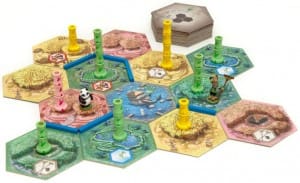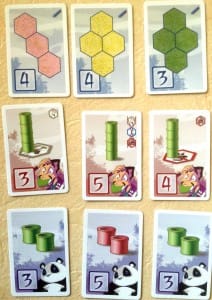I love board games probably as much as I love video games. There is something magical about sitting at a table with all of your friends, rolling dice, playing cards, and laughing as a rascally panda eats the bamboo you’ve been trying so hard to grow. Well, that got pretty specific pretty fast. Let me tell you about Takenoko.
The components in Takenoko are wonderful. This is one of those games that If someone sees you playing, they will ask what you are playing. The wooden bamboo shoots look fantastic with their bright popping colors and clever design. It’s just magical seeing this board with several stalks of different colored bamboo sticking up. The plot tiles are all colorful and look great once you start forming the land. The small objective cards are also bright and do their job with minimal text. The miniatures for the Gardener and Panda are pre-painted and look delightful, especially that little panda. I would say my one gripe with the components is that the weather dice can be a little hard to read with some of the effects. It’s probably just an issue with the kind of paint used in the etchings and it isn’t THAT bad, but it is noticeable.
The theme of Takenoko is about China giving Japan a giant panda as a peace offering. The Japanese Emperor has given the players the task of caring for the panda as well as making sure the bamboo garden stays in top notch condition. I find the theme a wonderful departure from the typical Sci-fi or Fantasy board games that I also enjoy. I mean, shooting aliens in the face and setting orcs on fire is fine, but dammit sometimes I wanna grow some bamboo and a feed a giant cuddly bear.
The rulebook is bright and colorful with a lot of pictures to show you how things should work. I felt overall it was pretty thorough about most of everything, but not overwhelming. At first look it seems like a bunch of moving parts but once you begin to see the game in action that “OHHHHH OK!” pops into your head. Playing Takenoko with some players fairly new to the hobby, they picked up the game rather quickly.
Takenoko plays very well. It’s a competitive game but not entirely cut throat. Your decisions can affect your opponents, but not always in negative ways. Basically as you play Takenoko everyone is building this board filled with Pink, Green, or Yellow plots of land. These plots of land, when irrigated can produce Bamboo of the color tile. In order to score points you have objective cards that show you what needs to be done in the fields. There are three types of cards, Plot objectives, Gardener objectives, and Panda objectives. The plot objectives can be played when the plots of land look like what is on the card. The gardener objectives can be played when the correct formation of bamboo has been grown as shown on the card. The panda objectives can be played when you’ve made the panda eat the bamboo shown on the card. During your turn you have two actions where you can do several different things. You can place plots of land on the board, irrigate plots of land, move the gardener to grow bamboo, move the panda to eat bamboo, or draw an objective card. It plays MUCH smoother than it may sound, I promise. I have played it with two people and with four people. Four people seems to take a bit long than the estimated 45 minutes, but it goes by pretty fast. Many games feel a little dull at the two player mark for me, but this game still felt fun at two players. The fact that the board will be different every time means that it will always be different.
Takenoko is an excellent gateway game. If you are new to designer board games and are a little overwhelmed with the amount of games there are out there, Takenoko is perfect for you. It’s fun, competitive, looks fantastic, and it has a cute panda! Even if you are a veteran table top gamer, I believe Takenoko is perfect for your collection because ultimately its just plain fun and filled with a heck of a lot of charm.







